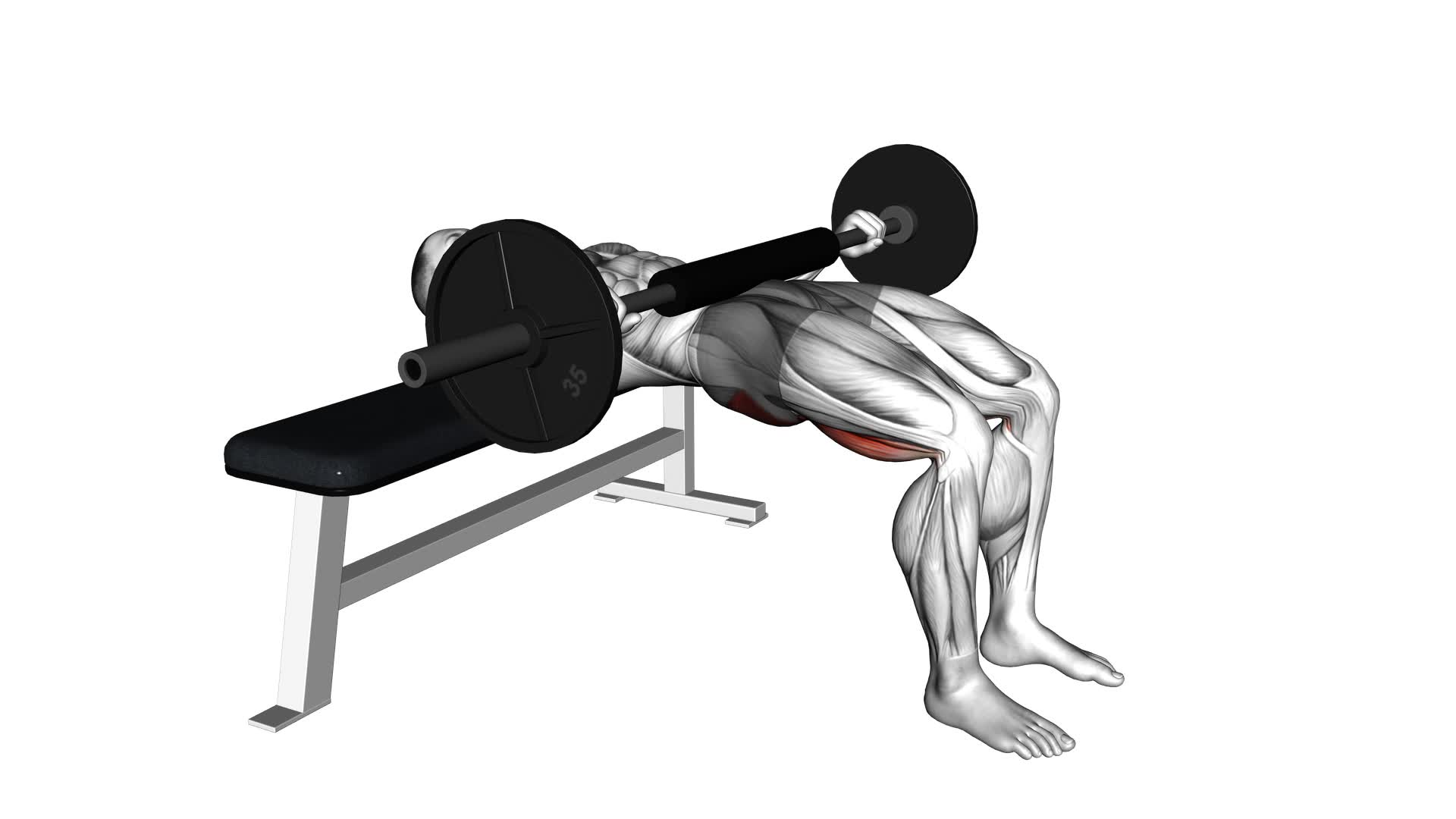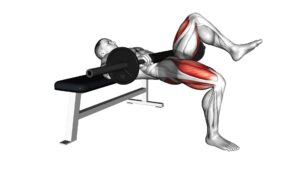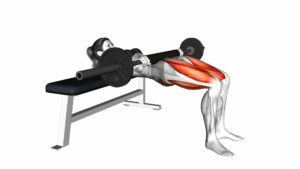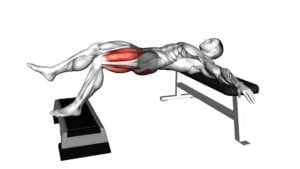Barbell Hip Thrust – Video Exercise Guide & Tips

Are you looking to strengthen your glutes and improve your overall lower body strength? Look no further than the barbell hip thrust.
Watch This Exercise Video
This exercise targets your glute muscles in a way that no other exercise can. In this article, we will guide you through proper form and technique, discuss the benefits, and offer variations and progressions to challenge yourself.
Avoid common mistakes and maximize your results with our expert tips.
Let's get started!
Key Takeaways
- Proper form and technique are crucial for barbell hip thrusts, including positioning yourself correctly and keeping your core engaged throughout the exercise.
- Barbell hip thrusts target the glutes, hamstrings, and lower back, improving overall lower body strength and power.
- This exercise can help prevent injuries in the lower back, hips, and knees while shaping and toning the glutes for a more defined appearance.
- To maximize results, incorporate variations and progressions, avoid common mistakes, and focus on proper muscle activation and increasing the weight gradually.
Proper Form and Technique
To perform the barbell hip thrust with proper form and technique, position yourself on the floor with your back against a bench and your feet flat on the ground. This exercise is essential for activating and strengthening your glute muscles, which play a crucial role in stabilizing your hips and improving your overall lower body strength. The barbell hip thrust specifically targets the glutes, making it an effective exercise for building a strong and toned backside.
Proper form is key to getting the most out of this exercise. Start by placing a barbell across your hips, making sure it's secure and stable. Take a deep breath in and then exhale as you drive your hips up towards the ceiling, squeezing your glutes at the top of the movement. Keep your core engaged and your back straight throughout the exercise to avoid unnecessary strain on your lower back.
While the barbell hip thrust is a popular exercise for glute activation, there are alternatives that can be just as effective. These include exercises such as glute bridges, single-leg hip thrusts, and cable pull-throughs. Incorporating a variety of these exercises into your routine can help to target your glutes from different angles and maximize your overall glute development.
Benefits of Barbell Hip Thrusts
Experience the numerous benefits of incorporating barbell hip thrusts into your fitness routine. This exercise targets the glutes, hamstrings, and lower back, making it an effective way to build strength and improve overall lower body power.
Here are four key benefits of incorporating barbell hip thrusts into your workouts:
- Muscle activation: Barbell hip thrusts specifically target the glute muscles, helping to activate and strengthen them. Strong glutes not only improve your overall lower body strength, but they also contribute to better posture, stability, and athletic performance.
- Increased strength and power: By focusing on the hip extension movement, barbell hip thrusts help to build strength and power in the glutes and hamstrings. This can directly translate to improved performance in activities such as running, jumping, and lifting.
- Injury prevention: Strong glutes play a crucial role in preventing injuries, especially in the lower back, hips, and knees. By strengthening these muscles through barbell hip thrusts, you can help reduce the risk of common lower body injuries.
- Improved aesthetics: Barbell hip thrusts can help shape and tone the glutes, giving you a more defined and sculpted appearance. Adding this exercise to your routine can help you achieve the well-rounded, strong lower body you desire.
Incorporating barbell hip thrusts into your fitness routine can provide a multitude of benefits, from increased muscle activation and strength to injury prevention and improved aesthetics. Don't miss out on this effective exercise for your lower body!
Variations and Progressions
To continue the discussion from the previous subtopic, let's explore some variations and progressions of the barbell hip thrust exercise.
Variations and progressions can help you challenge your muscles in new ways and continue to make progress in your strength training journey.
One advanced modification of the barbell hip thrust is the single-leg hip thrust. This variation involves performing the exercise with only one leg at a time, which increases the demand on your glutes and hamstrings.
Another option is to use different types of equipment for the exercise. If you don't have access to a barbell, you can use a dumbbell or a resistance band to add resistance. Alternatively, you can try using a hip thrust machine, which provides a more stable and controlled movement.
These equipment options can add variety to your workouts and help you target your glutes and hamstrings from different angles.
Remember to always maintain proper form and gradually increase the difficulty of the exercise to avoid injury and continue progressing.
Common Mistakes to Avoid
Now let's delve into some common mistakes to avoid when performing the barbell hip thrust exercise. To ensure you get the most out of this exercise and reduce the risk of injury, keep the following technique tips in mind:
- Avoid arching your lower back excessively: When thrusting your hips upward, it's important to maintain a neutral spine position. Excessive arching of the lower back can put unnecessary strain on your lumbar spine.
- Don't push your knees too far forward: During the movement, make sure to keep your knees in line with your toes. Pushing your knees too far forward can cause undue stress on your knee joints.
- Avoid using too much weight: While it's important to challenge yourself, using excessive weight can compromise your form and lead to poor technique. Start with a weight that allows you to maintain proper form throughout the exercise.
- Don't rush the movement: The barbell hip thrust should be performed in a controlled manner. Avoid using momentum or swinging your body to lift the weight. Focus on squeezing your glutes and driving through your heels to lift the barbell.
Tips for Maximizing Results
To further enhance your results, consistently incorporate the following tips into your barbell hip thrust routine.
First and foremost, focus on maximizing glute activation. This can be achieved by really squeezing your glutes at the top of each rep and holding the contraction for a second or two before lowering the weight. By emphasizing this mind-muscle connection, you'll ensure that your glutes are doing the majority of the work during the exercise.
Additionally, incorporating resistance bands into your barbell hip thrust routine can take your results to the next level. Loop a band around your knees or thighs and perform the exercise as usual. The band adds extra resistance, forcing your glutes to work even harder. This can result in increased muscle activation and growth over time.
Another tip for maximizing results with the barbell hip thrust is to gradually increase the weight you're using. As you get stronger, don't be afraid to challenge yourself with heavier weights. This progressive overload will stimulate muscle growth and help you achieve your desired results faster.
Lastly, make sure you're performing the exercise with proper form. Maintaining a neutral spine, engaging your core, and keeping your knees in line with your toes are all crucial aspects of the barbell hip thrust. By executing the exercise correctly, you'll target the glutes more effectively and minimize the risk of injury.
Frequently Asked Questions
How Heavy Should the Barbell Be for a Beginner Starting Out With Hip Thrusts?
When starting out with hip thrusts, it's important to choose an ideal weight for the barbell. As a beginner, you'll want to start with a weight that challenges you but is still manageable.
Common mistakes include using a weight that's too heavy, which can lead to improper form and potential injuries. It's best to start with a lighter weight and gradually increase as you become more comfortable and confident with the exercise.
Can Pregnant Women Safely Perform Barbell Hip Thrusts?
During pregnancy, it's important to prioritize safety and consult your healthcare provider before attempting new exercises.
When it comes to barbell hip thrusts, it's recommended to avoid this exercise during pregnancy due to the potential strain it can place on your pelvic floor and lower back.
Instead, consider focusing on other exercises that are safe and beneficial for pregnant women, such as prenatal yoga or swimming.
Always prioritize your health and safety during this special time.
Are There Any Alternatives to Using a Barbell for Hip Thrusts?
Looking for an alternative to using a barbell for hip thrusts? Resistance bands are a great option. They provide a different type of resistance and target your glutes effectively.
Using bands can also help improve stability and balance. Plus, they're portable and easy to use at home or on the go.
Incorporating resistance bands into your hip thrust routine can add variety and challenge to your workout, helping you achieve stronger glutes.
How Often Should Barbell Hip Thrusts Be Performed for Optimal Results?
For optimal results, it's important to consider the frequency of your barbell hip thrusts. Doing them consistently will have the most benefits.
While there isn't a one-size-fits-all answer, experts generally recommend incorporating hip thrusts into your routine 2-3 times per week. This frequency allows your muscles to recover and grow stronger, maximizing the effectiveness of the exercise.
Can Barbell Hip Thrusts Help Improve Athletic Performance in Other Sports?
Barbell hip thrusts can have a positive impact on your sprinting performance and vertical jump height. By targeting the glutes and hamstrings, this exercise helps to improve explosiveness and power in your lower body.
The increased strength and activation in these muscles can translate to faster sprints and higher jumps.
Incorporating barbell hip thrusts into your training regimen can be beneficial for athletes in various sports looking to enhance their athletic performance.
Conclusion
In conclusion, the barbell hip thrust is an effective exercise for targeting and strengthening the glutes. By maintaining proper form and technique, you can experience the benefits of this exercise, such as improved hip power and stability.
There are also various variations and progressions to challenge yourself and avoid plateaus. Remember to avoid common mistakes and follow the tips provided to maximize your results.
Incorporate the barbell hip thrust into your workout routine for optimal glute development.

Author
Years ago, the spark of my life’s passion ignited in my mind the moment I stepped into the local gym for the first time. The inaugural bead of perspiration, the initial endeavor, the very first surge of endorphins, and a sense of pride that washed over me post-workout marked the beginning of my deep-seated interest in strength sports, fitness, and sports nutrition. This very curiosity blossomed rapidly into a profound fascination, propelling me to earn a Master’s degree in Physical Education from the Academy of Physical Education in Krakow, followed by a Sports Manager diploma from the Jagiellonian University. My journey of growth led me to gain more specialized qualifications, such as being a certified personal trainer with a focus on sports dietetics, a lifeguard, and an instructor for wellness and corrective gymnastics. Theoretical knowledge paired seamlessly with practical experience, reinforcing my belief that the transformation of individuals under my guidance was also a reflection of my personal growth. This belief holds true even today. Each day, I strive to push the boundaries and explore new realms. These realms gently elevate me to greater heights. The unique combination of passion for my field and the continuous quest for growth fuels my drive to break new ground.







